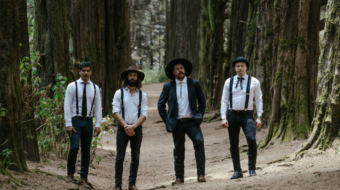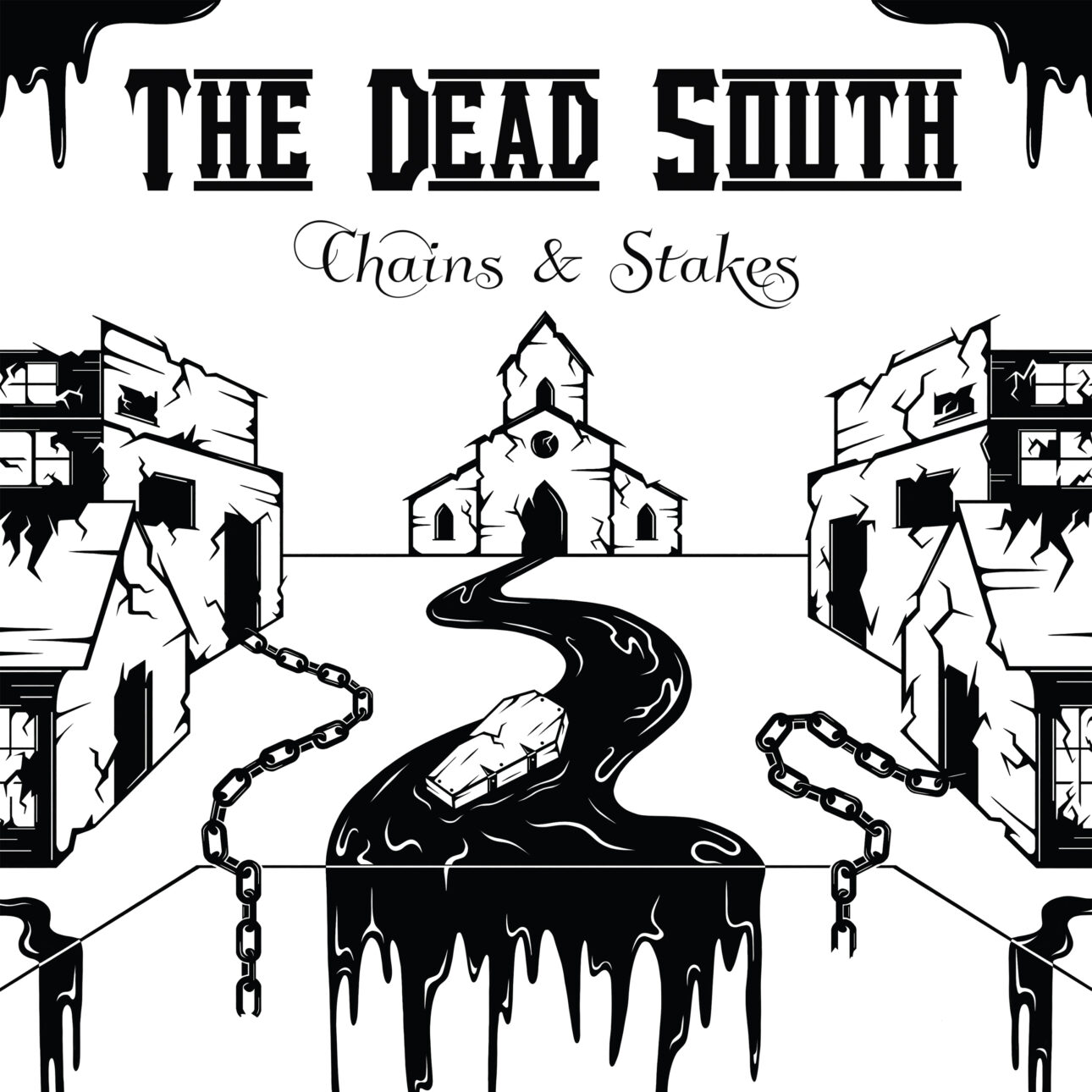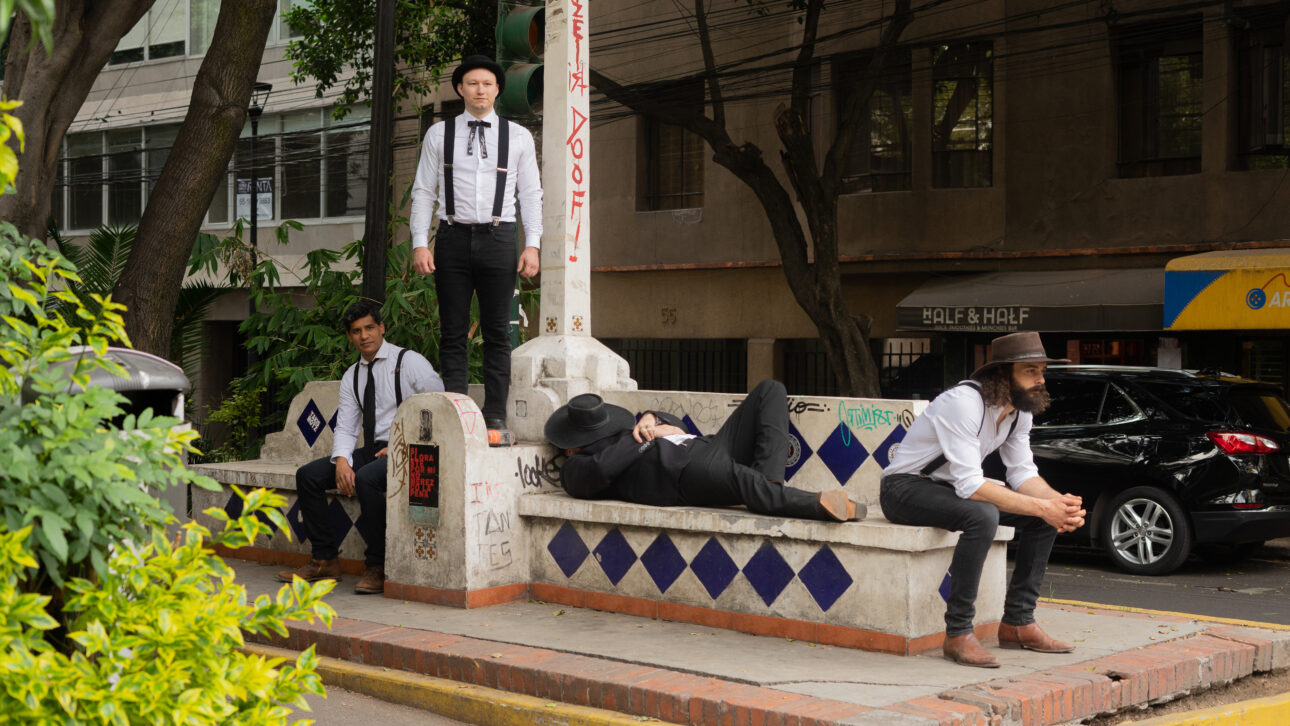
More from Spin:
- 5 Albums I Can’t Live Without: Nathaniel William Hilts of The Dead South
“We were a bar band,” says The Dead South’s Nate Hilts. That was over 10 years ago. Since then, The Dead South have grown organically, first across their native Canada, then across Europe where they’ve toured numerous times. Hilts says The Dead South holds, “A Western mystique” for Europeans. “We’re like a spectacle,” he continues. “We were playing in bars and cafés and the tiniest venues. People could get that close exposure. They could get personal with it. That kept growing word of mouth.”
The Dead South dress up in variations of period costume with black trousers, suspenders, crisp white shirts, some kind of flourish-y neck accessory and perhaps a hat. Once outfitted in what could be referred to as Amish chic, they go down to their local watering hole to play some jams to an enthusiastic and similarly attired audience.
They still look the cosplay bar-band part, but the acoustic string-based four-piece from Regina, Saskatchewan—one of the square provinces north of the border—has come a long way from the honky tonk. Their sound is identified by mandolin which both Hilts and guitarist/vocalist Scott Pringle play, and banjo, which is handled by Colton Crawford. To round out the string instruments, Danny Kenyon, who also sings, has his fingers on cello and bass. Their musical style is a long thread of hyphenated genres: alternative-folk-bluegrass-punk rock. When I suggest that they’re actually “Canadiana,” Hilts sniggers in approval.

Over the last dozen or so years, The Dead South have released three studio albums, a live album and three EPs. They have earned three Juno Awards, one for Breakthrough Group of the Year and two for Traditional Roots Album of Year for 2016’s Illusion & Doubt and 2019’s Sugar & Joy. The latter was produced by Grammy winner Jimmy Nutt at his Nutthouse Recording Studio in Muscle Shoals, Alabama. For its fourth album, Chains & Stakes, the group enlisted Nutt once again, this time taking him to Mexico City where they recorded the album in 12 days at Panoram Studios.
The album is preceded by the singles “Tiny Wooden Box” and “A Little Devil.” These give an indication of where The Dead South is headed, which is even loftier heights. They are making their debut at the Grand Ole Opry on Feb. 10, the day after Chains & Stakes’ release. The Dead South are regulars in Nashville, including at the city’s famed Ryman Auditorium, to which they will return for two nights this summer during their extensive world tour which kicks off two days after their Grand Ole Opry appearance.
Hilts seems unphased by it all as he leans back in his seat, enjoying the calm before the storm of the album’s release, hitting the road for the next few months, performing and talking about Chains & Stakes, beginning with SPIN.
SPIN: Why did you decide to record in Mexico City?
NATE HILTS: It was just something different. Besides our first EP and our first album, we haven’t done any albums at the same place. It’s fun. We went down for a demo session and checked out the studio with Jimmy Nutt. When we came back, he brought Cody [Simmons] who engineered the last album and they set up the whole room so it could sound the way they wanted.
The studio is called Panoram Studios and it’s in Condesa, which is a really nice area.
Did the environment have an impact on the music?
Everything was so chill over there. I found Condesa to be quite chill. Our Airbnb there was a 20-minute walk to the studio. Take your time getting there in the morning. Stop for a coffee and a nice pastry. Walk in traffic, see it all, then you get in there and it’s this nice spot. You almost forget you’re in Mexico City. Go outside with your shirt off, just chill in the sun and go back in. The vibe was definitely super chill the whole time. When we had to go to other places to shoot some video, that was quite chaotic.
A few songs were written over COVID. And some bits and pieces we came up with over COVID. Some were written when we were doing that demo week. And then some were written in between coming into the recording. It was during downtime mostly.
Did you have conversations with Jimmy Nutt about where you wanted to go with the new album?
Jimmy asks, “What sound of album do you like and where do you want this to sit in that aspect?” We kept going through different scenarios, like, “We really like this System of a Down album, but we don’t really want to sound like System of a Down. We want to show some influence.” We had to come to a happy medium with every song and told Jimmy what we thought it should sound like. He either agreed fully or said, “I think it actually needs a little of this,” and we would adjust as we went every time. He played with a lot of different plates and sounds to get a different feel for the song. It was a lot of conversations like that, but no defined plan.
The beautiful part about working with Jimmy is we co-produce. We present him with what we have, or what one person has, and he listens while everyone else jams and you explain the structure to the other guys and they start to write parts. When he’s listening, he either loves what you’re doing, or he will suggest trying out something new. Of course, we want to try that out as well, just to see what that’s like. We do a give or take on which feels better, and then we do a “feeling decision” on those things.
Our relationship with Jimmy, the cohesive work we do together is just so smooth. It’s going to be hard if we ever decide not to work with Jimmy or he’s busy when we’re trying to do our next album. Any ideas we have, he can work it out in his head and explain that to Cody, and they’ll just make it happen in front of you. That’s how we’re able to get out in 12 days because of how we can communicate and understand each other and formulate things so fast. It’s really nice.

Were there songs that changed dramatically from inception to when you put them down in the studio?
Danny [Kenyon] wrote the song “Yours to Keep.” He wanted that song to get bigger and we did the reverse. We kept it as bare bones and raw as possible because the feel of it hit way harder when it was simple and to the point. You get more emotion out of it. Some of the other songs they came together with added instrumentation. I would come up with a song with acoustic and my voice. The way the guys can tell stories with their instruments, it always adds so much more to a song. We’re coming up with different timing for a good feel at the right moment.
The hardest one for all of us was “Completely, Sweetly.” Colton wrote that song on the banjo and he was in a metal phase when he was doing it. He loves playing metal on the banjo. He wrote the guitar part, the banjo part and the bass part. We had to learn to play to that style, which wasn’t too bad. But then trying to sing to what he wrote, because I’m used to singing to what I write, or at least it’s closer to what I’m normally doing, that one was probably changed the most.
Songwriting can be so hard. Even if you got your word, where do you add your inflections to make the word hit harder, give it more meaning, or flow better?
Do all of you write lyrics? Or is that mainly you?
If Colton is writing a song on the banjo, he’s really good at coming up with structure, but I’ll take the lyrics because I’m going to sing those ones, for the most part. Danny writes his own lyrics. He’s written “Yours to Keep” and “In Hell I’ll Be Good Company.” Scotty writes lyrics and I think I’ve only sung one of Scotty’s songs, which is “The Dead South.” Normally when the guys write the lyrics, they sing their own songs.
Writing songs is different all the time for me. I was kind of hoping I would eventually come up with a method that is solid and works. But sometimes I’ll be humming in my head, and I like the melody and words will start to formulate and I’ll pick up a guitar and try and figure out what to do with that. Or I’ll be messing around on the guitar and find a nice chord progression that I like and try to do the melody over that, and words will start to build and this whole story will come out of that. That’s probably the most formative one that I use is the guitar first, come up with a nice chord progression and then build off that. I experience stories off of sounds. I hear sounds and I want to start telling a story to the sound.
To see our running list of the top 100 greatest rock stars of all time, click here.
Source link
